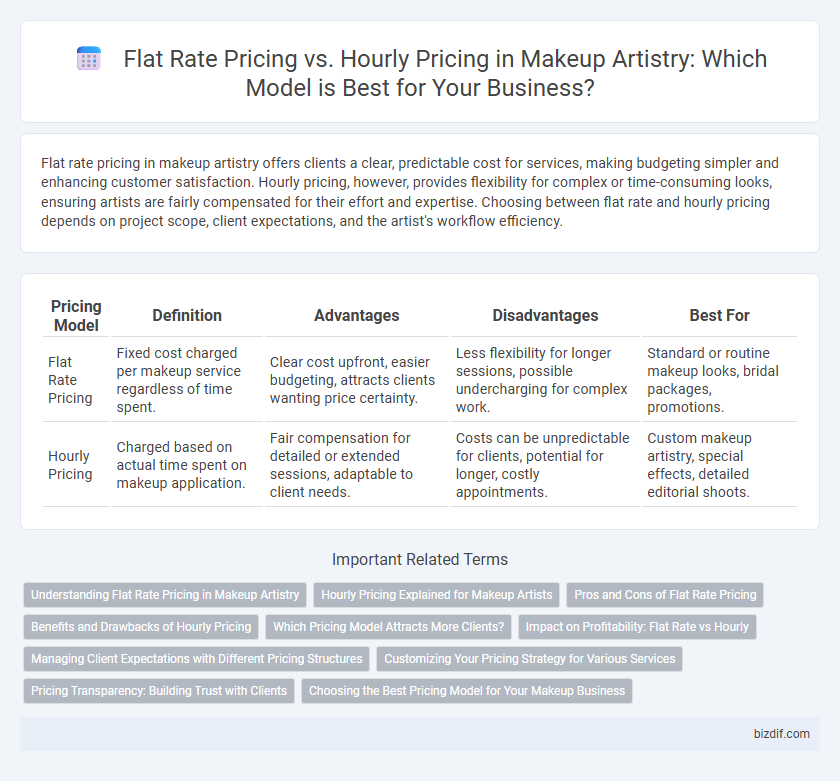Flat rate pricing in makeup artistry offers clients a clear, predictable cost for services, making budgeting simpler and enhancing customer satisfaction. Hourly pricing, however, provides flexibility for complex or time-consuming looks, ensuring artists are fairly compensated for their effort and expertise. Choosing between flat rate and hourly pricing depends on project scope, client expectations, and the artist's workflow efficiency.
Table of Comparison
| Pricing Model | Definition | Advantages | Disadvantages | Best For |
|---|---|---|---|---|
| Flat Rate Pricing | Fixed cost charged per makeup service regardless of time spent. | Clear cost upfront, easier budgeting, attracts clients wanting price certainty. | Less flexibility for longer sessions, possible undercharging for complex work. | Standard or routine makeup looks, bridal packages, promotions. |
| Hourly Pricing | Charged based on actual time spent on makeup application. | Fair compensation for detailed or extended sessions, adaptable to client needs. | Costs can be unpredictable for clients, potential for longer, costly appointments. | Custom makeup artistry, special effects, detailed editorial shoots. |
Understanding Flat Rate Pricing in Makeup Artistry
Flat rate pricing in makeup artistry offers clients a fixed cost regardless of time spent, providing clarity and budgeting ease for services like bridal makeup or special events. This pricing model emphasizes the overall value and expertise of the artist rather than the duration of application, encouraging efficiency and high-quality results. Understanding flat rate pricing helps clients avoid unexpected fees and ensures makeup artists are fairly compensated for their skill and creative effort.
Hourly Pricing Explained for Makeup Artists
Hourly pricing for makeup artists offers a flexible and transparent billing method, allowing clients to pay specifically for the time dedicated to their look. This model benefits artists by accurately compensating for complex or time-intensive services, such as bridal or editorial makeup, where precision and detail vary significantly. By charging hourly, makeup professionals can accommodate varying project scopes while maintaining fair compensation based on the actual work performed.
Pros and Cons of Flat Rate Pricing
Flat rate pricing in makeup artistry offers clients clear, upfront costs, simplifying budgeting and often attracting more bookings by eliminating billing surprises. It can encourage efficiency for artists by rewarding quicker service without reducing pay but may risk undercompensating if complex jobs require extra time. However, flat rates may not reflect varying project scopes, potentially leading to dissatisfaction if the service demand exceeds the agreed price.
Benefits and Drawbacks of Hourly Pricing
Hourly pricing in makeup artistry offers flexibility by charging clients based on the actual time spent, which can accommodate varying levels of service complexity. However, it may lead to unpredictable costs for clients, causing uncertainty and potentially deterring bookings. Additionally, artists might feel pressured to work quickly, risking quality to maximize efficiency and income.
Which Pricing Model Attracts More Clients?
Flat rate pricing often attracts more clients in makeup artistry by offering clear, predictable costs that enhance trust and simplify decision-making. Hourly pricing may deter potential clients due to uncertainty about the final price and fear of escalating costs. Competitive flat rates aligned with market standards tend to increase bookings and client loyalty in the beauty industry.
Impact on Profitability: Flat Rate vs Hourly
Flat rate pricing in makeup artistry ensures predictable revenue per session, simplifying budgeting and often increasing overall profitability by encouraging efficiency. Hourly pricing can fluctuate with appointment length, potentially reducing profit margins during slower services or long setups. Choosing flat rates aligns income directly with service value, while hourly rates tie profitability to time management and appointment complexity.
Managing Client Expectations with Different Pricing Structures
Flat rate pricing simplifies budgeting by providing clients with a clear, upfront cost for makeup artistry services, reducing surprises and enhancing trust. Hourly pricing offers flexibility for complex or extended sessions but requires precise communication to prevent misunderstandings about total costs. Makeup artists must clearly outline what each pricing structure includes to align client expectations with the service scope and avoid dissatisfaction.
Customizing Your Pricing Strategy for Various Services
Flat rate pricing offers consistency and transparency for clients seeking specific makeup artistry services like bridal packages or event looks, while hourly pricing provides flexibility for projects requiring variable time and complexity, such as editorial shoots or special effects makeup. Customizing your pricing strategy involves analyzing service duration, skill level, product costs, and client expectations to balance affordability and profitability effectively. Implementing a hybrid model that combines flat rates for standard services and hourly rates for bespoke requests ensures a competitive edge and accommodates diverse client needs.
Pricing Transparency: Building Trust with Clients
Flat rate pricing offers clients clear expectations by providing a fixed cost for makeup services, eliminating uncertainties tied to time variations. Hourly pricing can lead to fluctuating costs, potentially causing client hesitation or distrust due to unclear final charges. Transparent pricing structures, such as flat rates, foster trust by ensuring clients fully understand the investment required for professional makeup artistry.
Choosing the Best Pricing Model for Your Makeup Business
Flat rate pricing offers clients clear expectations and simplifies budgeting, making it ideal for standard makeup services with predictable time requirements. Hourly pricing provides flexibility for complex or customized looks, ensuring fair compensation for extended sessions and intricate artistry. Evaluating your service complexity, client base, and market rates helps determine whether flat or hourly pricing maximizes profitability and client satisfaction in your makeup business.
Flat rate pricing vs Hourly pricing Infographic

 bizdif.com
bizdif.com